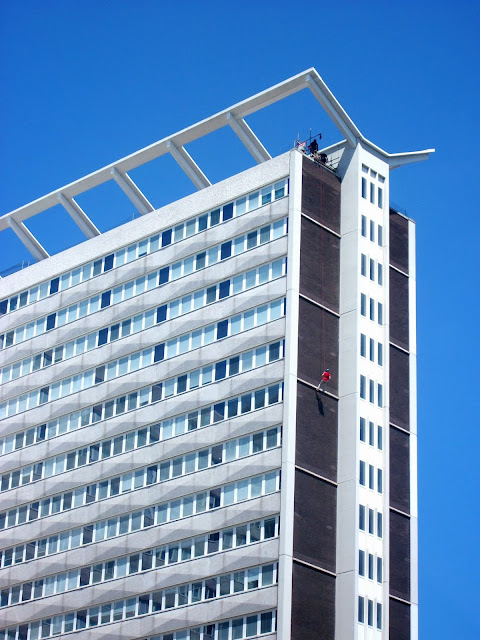Prefab, Post fab, and just fab

Every time I've visited Britain's largest remaining assembly of prefabs, the Excalibur Estate in Catford, it rains. I've become used to the sight of them huddled low under black clouds, the great horizontal strips beaten down by the weather. So yesterday, in steamy, swampy summer heat, jumping off the hopper bus I knew things would be different. There would be the bright light bouncing off the little chalets, and perhaps more importantly for me, I wouldn't have the anxiety of trying to find someone to talk to me about their home for the book I was researching. But the most striking image would be that second I turned into Baudwin Road, as it had been every other time. Usually I was struck by the contrast between the sprawling streets of Victorian terraces giving way to the mild no-rise modesty of the 187 Uni-Seco prefabs that form Excalibur. This time the shock was because, as the bus turned that corner, it wasn't prefabs I saw. It was vast stretches of grey-painted demolition barriers, swallowing up the prefabs, gardens, pavements and streetlights. It was eerily silent. A great patch of the estate had disappeared.

For many years it has been tough on the (mainly elderly) residents to carry out their normal lives in Excalibur. The threat of demolition, a lack of information from the council, the continuing battle pitting neighbour against neighbour, as much as against council, has given the whole estate a sense of blight, of insecurity. Now, with these huge barriers cutting across paths and streets, it is even harder for the remaining residents to carry out their day-to-day lives in ease and comfort. And earlier this week the first demolitions began. This has been controversial for many reasons, one of which is that the residents allege the demolitions have been badly carried out. The prefabs had been constructed using asbestos cement, and there are many procedures to be adhered to when dealing with demolishing it, including spraying the surfaces with water to minimise the dust, and covering it with plastic to contain it. The residents allege that this has not been happening, and instead the prefabs have been grabbed and dumped into skips, causing clouds of asbestos dust to fly into the air. Here's a video from the residents from this week, with comments from the demolition contractor below. You can make up your own mind.
Regardless of the manner of demolition, the destruction of the Excalibur Estate is one to be mourned. The 187 Uni-Seco prefabs here represent a significant piece of London's working class history. Many of the residents do not want to leave, and as you walk round the estate you can see why. These are little chalet bungalows, each with their own gardens. Most have been customised by the residents: painted, pimped and preened so that tudor-style beams sit next to country cottages, ranches beside modernist villas. With an increasingly elderly and vulnerable population coping with a complete lack of estate maintainence for many years, Excalibur has been easy for the council to divide and conquer. Thanks to English Heritage, six of the 187 prefabs will remain after demolition.

I tried to tell the story of the wartime temporary housing programme in Concretopia. But nothing brings a prefab to life so much as a visit to any of the few remaining clusters around the country. And despite the sadness that hangs over it, there's still something brilliant going on in Excalibur. The urgency of the situation, the eerie feeling of imminent destruction, makes a trip there even more essential for anyone interested in postwar history. It's not just seeing the estate for yourself that is rewarding. It's also the chance to visit to the (appropriately temporary) prefab museum, opened by photographer Elisabeth Blanchett in one of the old chalets.
The museum is only around until Open House Weekend in mid-September, and next weekend (Saturday 19th July at 2.30pm) Elisabeth is running a guided tour of the estate, which promises not to be missed. Although, if you do, she's also running a final tour on the 23rd August. Grab the opportunity, the museum and the prefabs won't be there very long now.
While I was having a poke round the museum several residents popped by and chatted away about their experience of living there, and talked about Margaret ('sod off, unless you're going to make me a cup of tea') who lived in that very prefab, until she had moved out to sheltered housing. This was an incredible bonus and made a visit feel extra-special. It's so lovely that the residents are keen to share their experiences. Sadly many of those experiences are about Lewisham Council's many and varied methods for making their lives a misery. As a resident of Lewisham, I'm gutted by the actions of the council. The whole affair has been badly managed, and the residents have been left feeling helpless and traumatised by the experience. Sure, these were only ever meant to be temporary homes, and they have been there for almost seventy years. They were also notorious nippy in the winter, and some of them had fallen into disrepair. But is the council going to be able to offer the residents anything comparable: a decent-sized detached bungalow with a nice garden at the heart of a genuinely flourishing community? Of course not. That kind of welfare state-era generosity has long gone.
Ranting aside, the museum itself is an intact Uni-Seco prefab, and each room contains artwork curated by Elisabeth Blanchett, including photography, sketches, film and found objects. There are tons of information sheets all over the place, and I was thrilled to see pictures of prefabs from my home town of New Addington, and a history of Shirley, the posh estate near where I grew up. The film, a documentary following the creation of the museum, with interviews from many elderly residents and peeking into their prefabs, is a wonderful record of the estate as it is now. But the thing that struck me most, as it had on every visit to Excalibur, is that here is a community here. People care what happens. And what is happening is being recorded by residents and artists. It made me wish that more places had this kind of spirit, and that it didn't take the threat of demolition to bring it to the attention of the rest of us.
The Prefab Museum is at 17 Meliot Road, Catford, SE6 1RY until 21st September. There are lots of special events scheduled too, more on them here. Entry is free, but they do take donations as it takes £100 per week to keep the museum open.
--
**UPDATE** 29th August 2014: Good news for the Prefab Museum, it's staying open until 2017, and you can now even help fund it on Kickstarter.
**UPDATE TO THE UPDATE ** 24th September 2014: Great news that the museum has been funded on Kickstarter and will remain open!















Brilliant work done by Elisabeth........This is very very sad and makes me cry.....We lived in 3 meliot road, we were born and bred there as they say......and Lewisham Borough Council havbe been despicable in their handling of the homes..........Back handers springs to mind for me.........
ReplyDeleteWhat years did you live there as I lived next door in number 1
DeleteCertainly not Lewisham's finest hour.
ReplyDelete